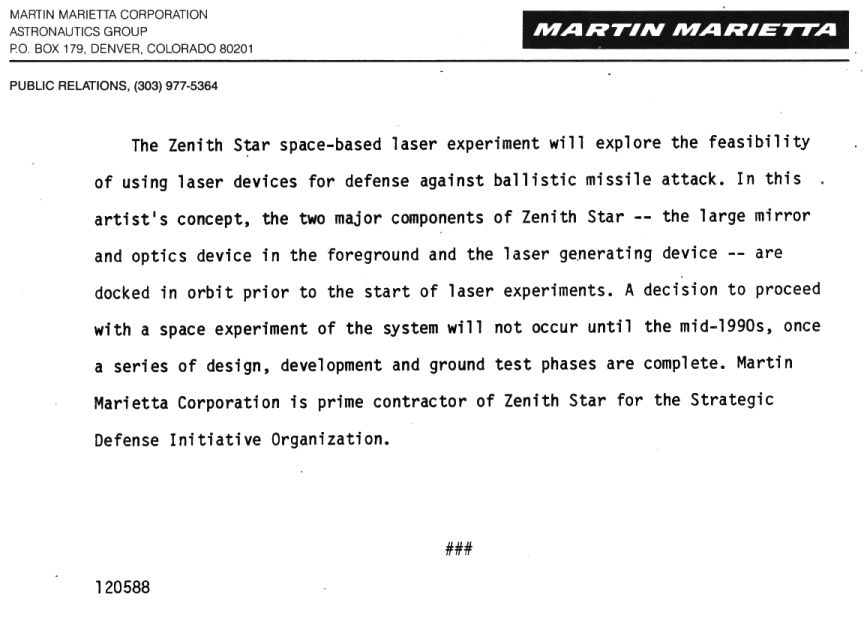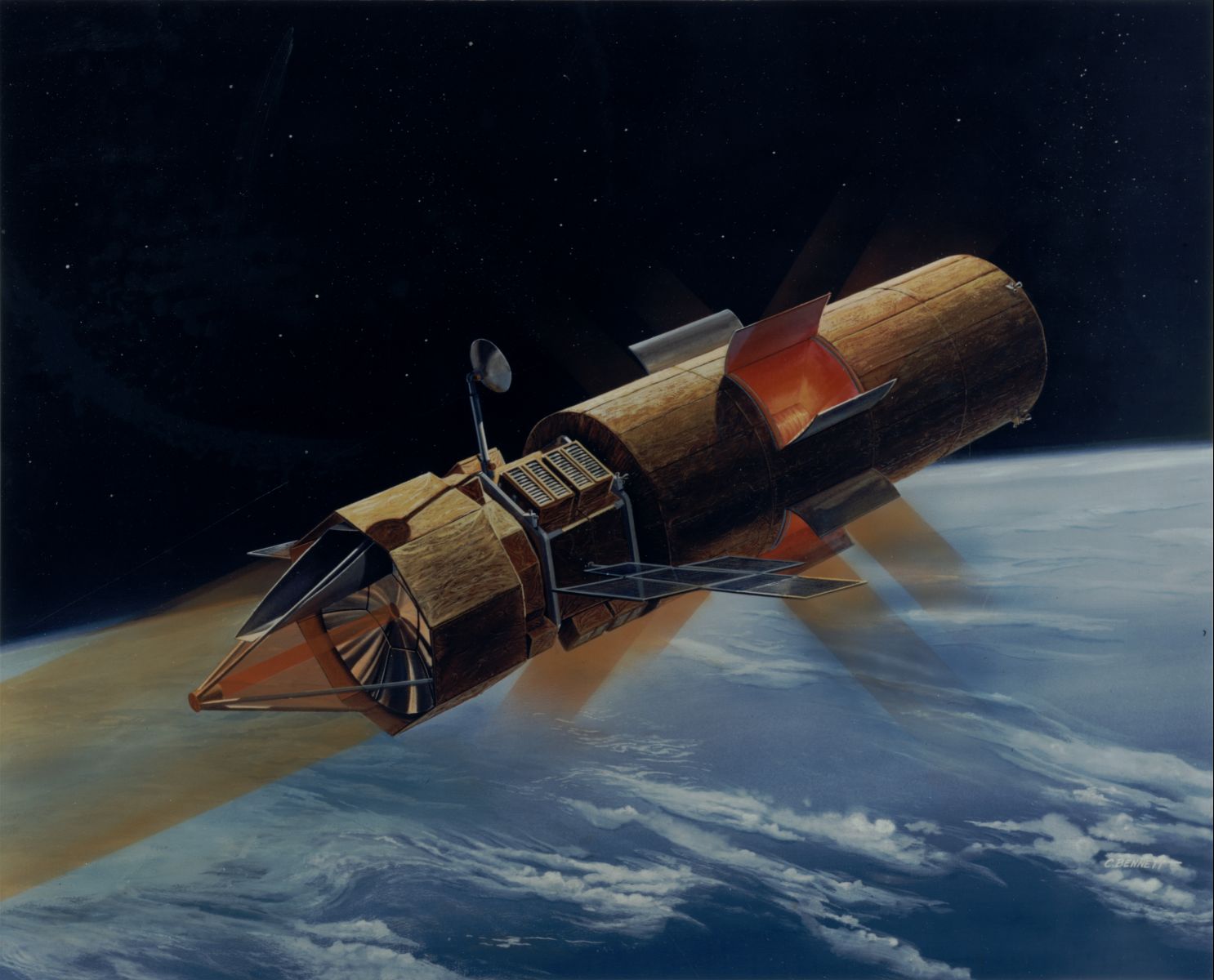The Strategic Defense Initiative was all the rage in my high school days. One of the ideas was to locate missile-killing lasers in low Earth orbit; when the Soviets finally pushed the button, their missiles would get zapped right out of the sky.
In order for that sort of thing to work, there’d have to be a lot of really powerful, really accurate, really reliable lasers in orbit. And in order to build such things in large quantities, you must first build experimental items. One of these was to be the Martin Marietta “Zenith Star” orbital laser platform, which was to be built around the “Alpha” laser platform.
Zenith Star, in most of its incarnations, was composed of two separately-launched spacecraft, joined together once in orbit. The aft portion was the actual Alpha laser generator; the forward portion was the optics and tracking system. The Alpha laser used the reaction of fluorine with hydrogen to generate the laser energy… about two megawatts worth. It would essentially have had an onboard hydrogen/fluorine rocket engine, with all the materials and thermal nightmares that that entails.
Back about 1988, I wrote to Martin asking for info on the Zenith Star (I think I wanted to build a scale model of it or some such). What I got back was a short press release and a glossy of a very nice painting. A few years ago I went hunting for that glossy… I wanted to make a scale model of it, and for the life of me I could not find it. It had utterly vanished. A few versions of it were available online, but they generally kinda sucked. Imagine my surprise when I stumbled across it a few days ago while digging through some old (*old*) rocket science/rocket engineering books in my hopeful-yet-unwise attempt at preparing for a job interview that doesn’t seem to be coming. Damned if I know why it was there, but there it was, and now it’s here.
8 Responses to “Zenith Star”
Sorry, the comment form is closed at this time.


Yeah, that’s the classic illustration of it.
It almost looks like the exterior is covered with a protective blanket of some sort, either for insulation or to protect it itself from laser attack.
It got to the full scale mock-up stage, and is here being shown off by Ronald Reagan:
http://cache2.asset-cache.net/xc/50361649.jpg?v=1&c=IWSAsset&k=2&d=E41C9FE5C4AA0A146A7C10D32B658512CF21640BCD514CCF17A87E66C4E574F5B01E70F2B3269972
http://cache3.asset-cache.net/xc/50361635.jpg?v=1&c=IWSAsset&k=2&d=E41C9FE5C4AA0A146A7C10D32B65851289C90510F059D29C67BF327F5F6C4810B01E70F2B3269972
…and here is a whole PDF on the thing:
http://www.dtic.mil/cgi-bin/GetTRDoc?Location=U2&doc=GetTRDoc.pdf&AD=ADA297331
More pictures here:
http://www.dtic.mil/cgi-bin/GetTRDoc?Location=U2&doc=GetTRDoc.pdf&AD=ADA297331
According to an article that appeared in Defense Daily on December 14th, 1989, 15 Zenith Star satellites were to be built and launched into space, so it sounds like this was going to be the beginning of a operational system.
Whoops, wrong second link: http://www.globalsecurity.org/space/systems/sbl-pics.htm
It would make an interesting subject for a model; maybe a combo kit in 1/144 or 1/72 with a Polyus battle station, its Soviet equivalent?
Funny how I was just reading about the Polyus a couple of days ago.
The enlarged ‘Barbarian’ version of a Titan was one fo the candidates to launch this thing:
http://www.astronautix.com/lvs/barianmm.htm
Zenith Star may have had some useful spin-offs in the civilian world.
To get the laser to be able to destroy ascending ICBMs, the parabolic mirror focusing assembly had to be able to compensate for atmospheric turbulence between the laser and target missile on a microsecond-to-microsecond basis;
That’s the same sort of technology used today in large ground-mounted astronomical telescopes with multi-segment main mirrors, where a laser “star” is fired into the upper atmosphere, and the telescope constantly makes subtle changes to the mirror segments to keep it in perfect focus despite atmospheric turbulence – giving the telescope the ability to generate images nearly as clear as the Hubble Space Telescope.
It would be interesting to know what happened to the big Zenith Star mock-up, as there sure aren’t many photos of it in existence.
Polyus was going to use a laser powered by CO2 in it’s final form:
http://www.airspacemag.com/space-exploration/Soviet-Star-Wars.html?c=y&page=1
There were some interesting launcher proposals that led up to the notional SDI launch vehicle, ALS, one of them being:
http://ntrs.nasa.gov/archive/nasa/casi.ntrs.nasa.gov/19860001749_1986001749.pdf
[…] Zentih Star was the name of a little known program to develop a space-based anti-missile laser during the Reagan SDI days. Vaguely shaped like the Hubble space telescope, it was much bigger and heavier, and could not be hauled into orbit in the Shuttle. Since the Shuttle was the biggest launch vehicle the US had, something new was needed. While several launch vehicles were proposed specifically to launch the Zenith Star, another idea was to use the proposed Shuttle C. Shuttle C was an expendable all-cargo derivative of the shuttle… stame external tank, same boosters, same “boattail” of the orbiter, but no wings, no cockpit, no recovery systems and an extended cargo bay. The Shuttle C was a NASA-MSFC idea that Martin Marietta ran with; the artwork below is likely Martin. […]